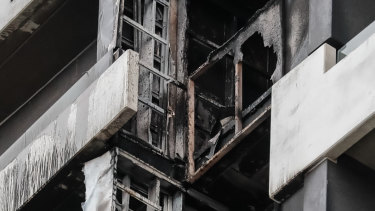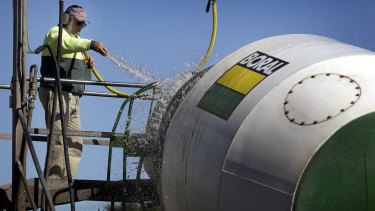
“Victoria has pushed for a national response to flammable cladding ever since the 2014 Lacrosse fire but has been met with frustrating resistance from the Federal Government.”

Firefighters inspect the damage at the Neo200 tower.Credit:Jason South
This comes as a national trade group for dozens of concrete and cement suppliers including two of Australia’s biggest, ASX-listed Boral and Adelaide Brighton, said the blaze showed the need for tougher restrictions on the use of combustible materials in high-rise construction. It called for a review of recent changes to the National Construction Code which it argues would weaken fire standards.
“Following the Grenfell Tower tragedy in London, a Senate inquiry raised serious concerns about the widespread use of non-compliant combustible cladding, and yet very little appears to have been done to make high-rise buildings safer in the event of a fire,” said Ken Slattery, chief executive of Cement Concrete and Aggregates Australia.
“The most effective way to provide absolute protection to residents and the brave men and women in the fire service is to ban combustible materials from being used in high-rise construction.”
In particular, the concrete and masonry industry leaders have highlighted the recent expansion of the tyes of buildings in which a number of so-called “deemed-to-satisfy” materials including cross-laminated timber can be used at up to 25 metres’ building height – about eight-to-nine storeys.

Boral is Australia's largest building materials supplier.Credit:Jack Atley
Elizabeth McIntyre, of industry groups Think Brick Australia and Concrete Masonry Association of Australia, called on the government to tighten standards in the code, rather than “opening up the code to the increased use of combustible products.”
But the calls have been criticised by other business groups in the building materials industry as an “opportunistic” and self-serving bid to force the use of more concrete and brickwork in high-rise construction.
“They are not acknowledging the rigorous scientific process our ‘deemed-to-satisfy’ [provision] is based on,” Forest and Wood Products Australia managing director Ric Sinclair said.
“Under a new definition, fire-protective timbers have to be clad in fire-resistant plasterboard and include sprinkler systems. So these buildings will actually be safer for residents because of the use of sprinklers other than some of the other materials which, at this height [25 metres], don’t require sprinklers.”
Cross-laminated timber is widely used in building construction overseas, including in Europe, America and Canada.
Mr Sinclair said it was “ludicrous” to link the dangerous aluminium-composite cladding involved in the Spencer Street apartment tower fire with other materials such as timber. “We fully stand by the testing we have done and the rigorous peer-reviewed process,” he said.
Federal Industry Minister Karen Andrews said the national construction code was “constantly under review” and involved extensive consultation with industry. The latest update was released last week, she said, ahead of it being adopted by the states and territories next month.
“The additional changes set out in National Construction Code 2019 will further enhance fire safety,” she said.
Among the changes is a requirement for apartment complexes and other residential buildings above three storeys and below 25 metres to have fire-sprinkler systems installed.
Ms Andrews said the code was reviewed in the wake of a 2014 cladding fire in an apartment tower in Melbourne’s Docklands and the 2017 Grenfell fire, with a range of fire-safety reforms fast-tracked.
Business reporter for The Age and Sydney Morning Herald.









 Add Category
Add Category